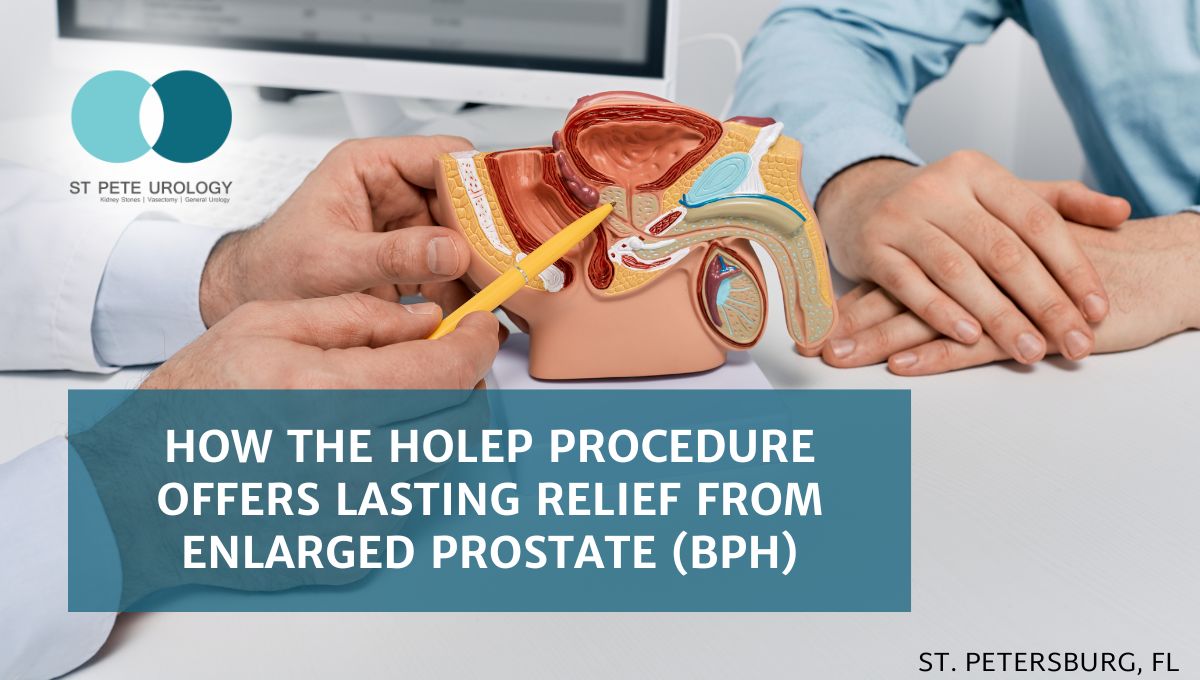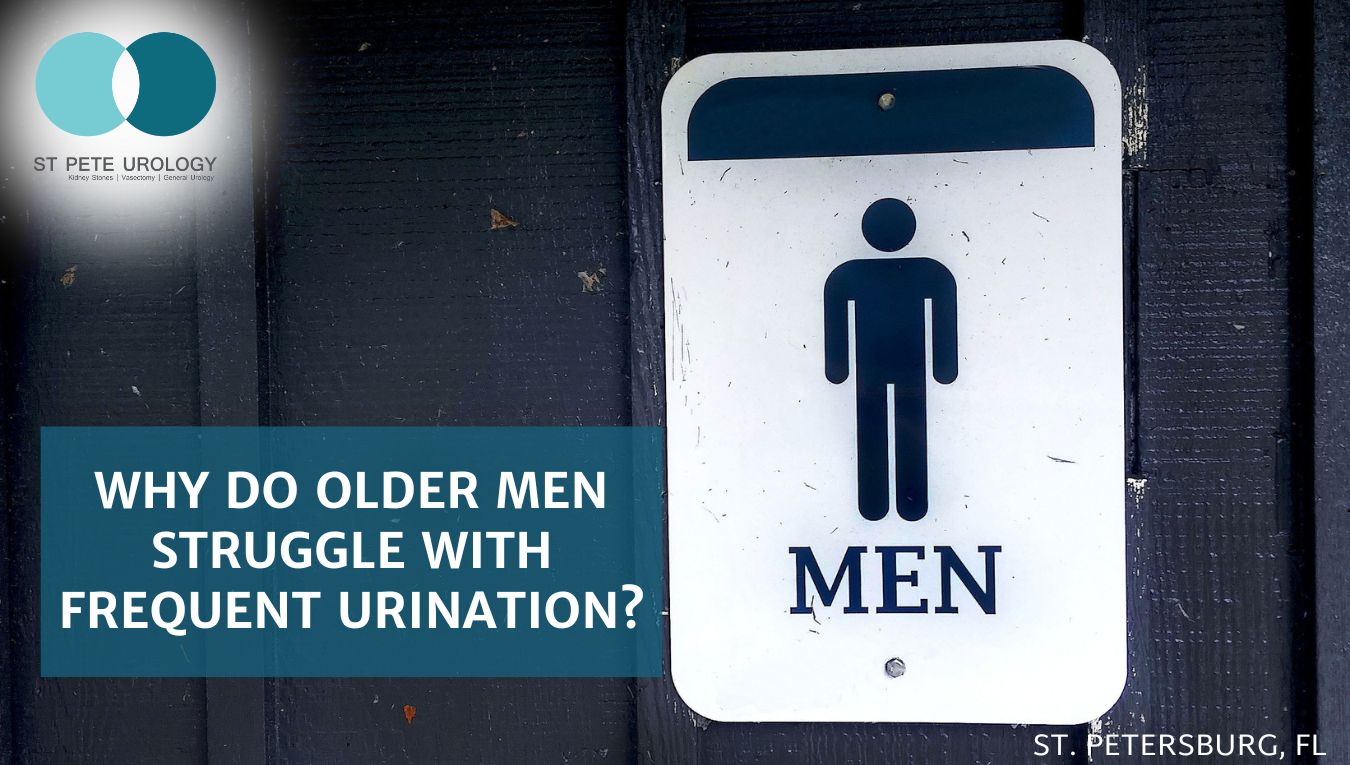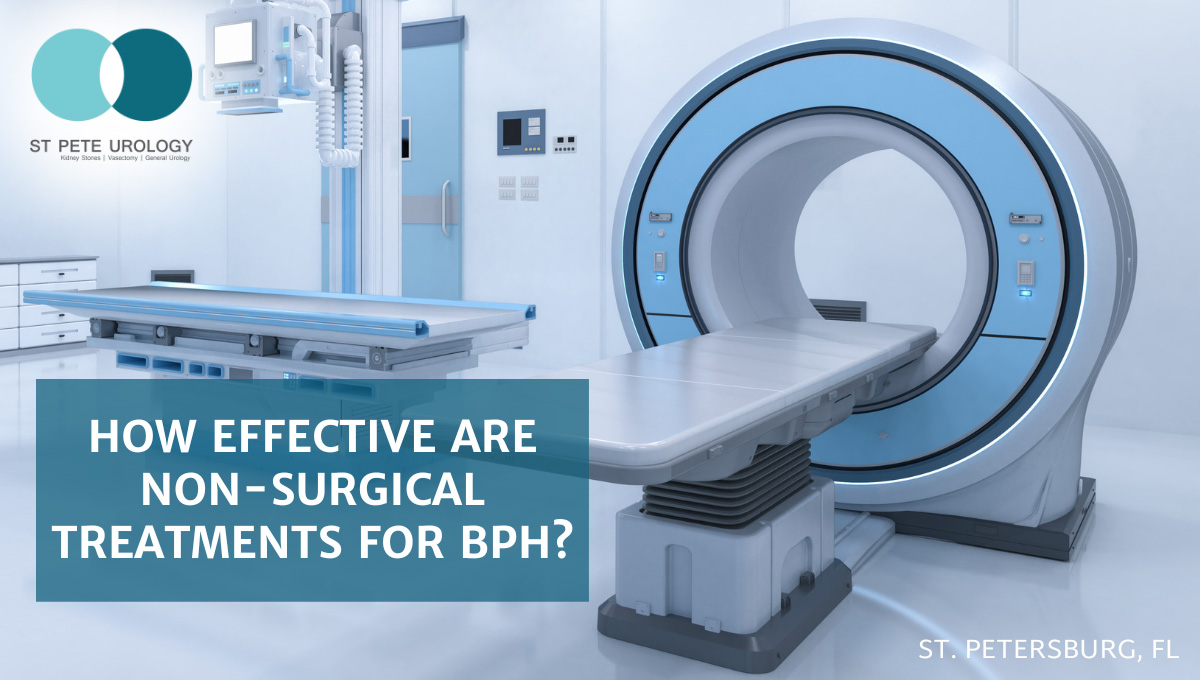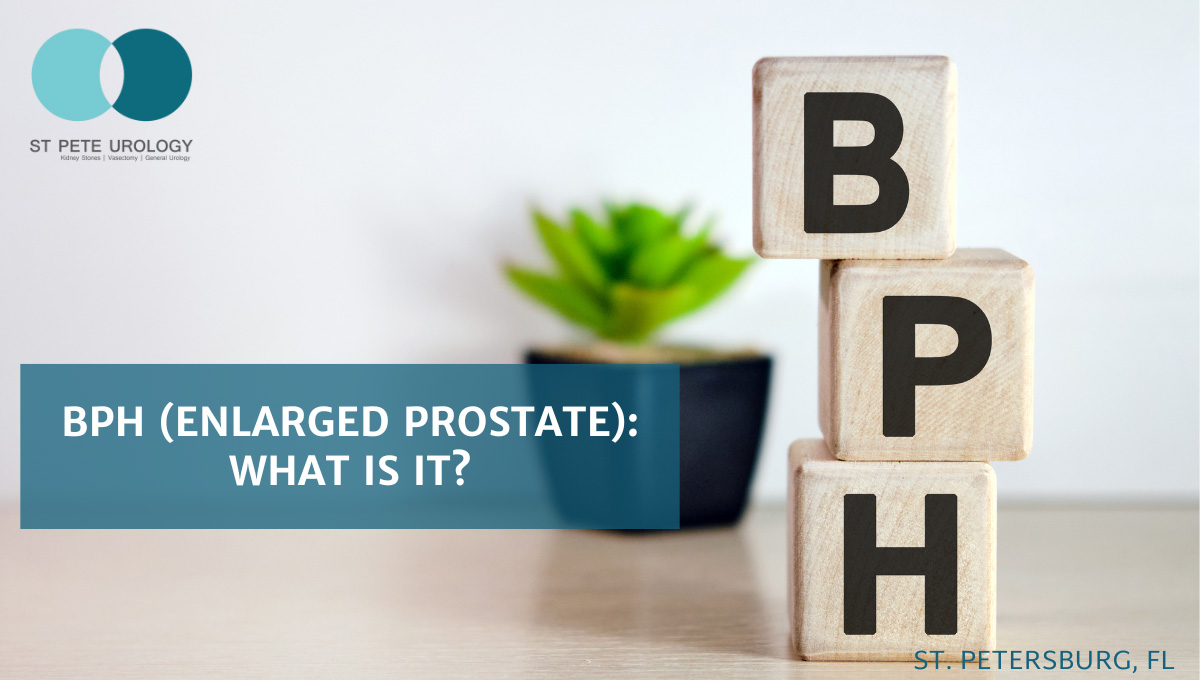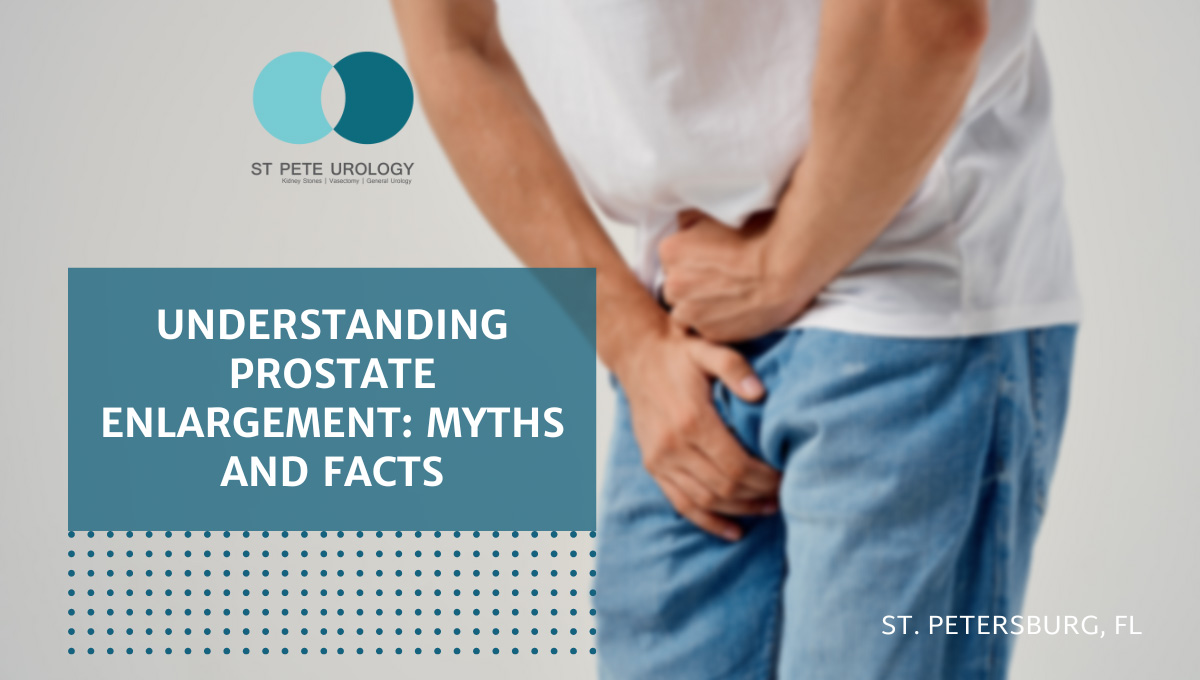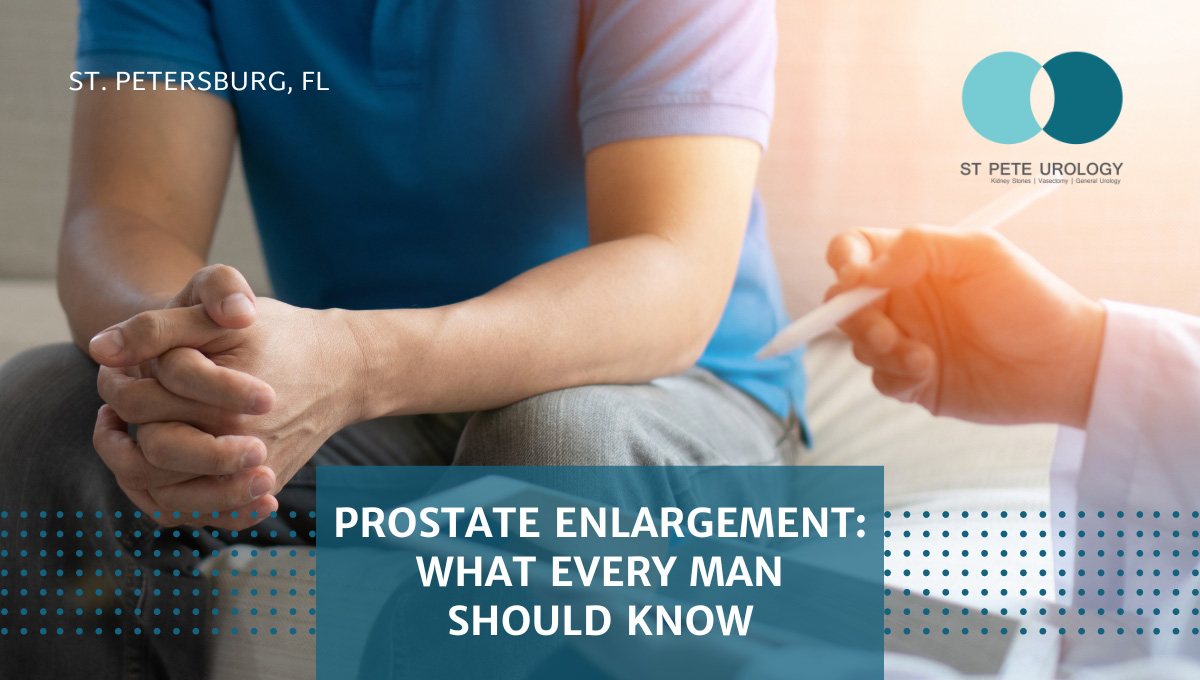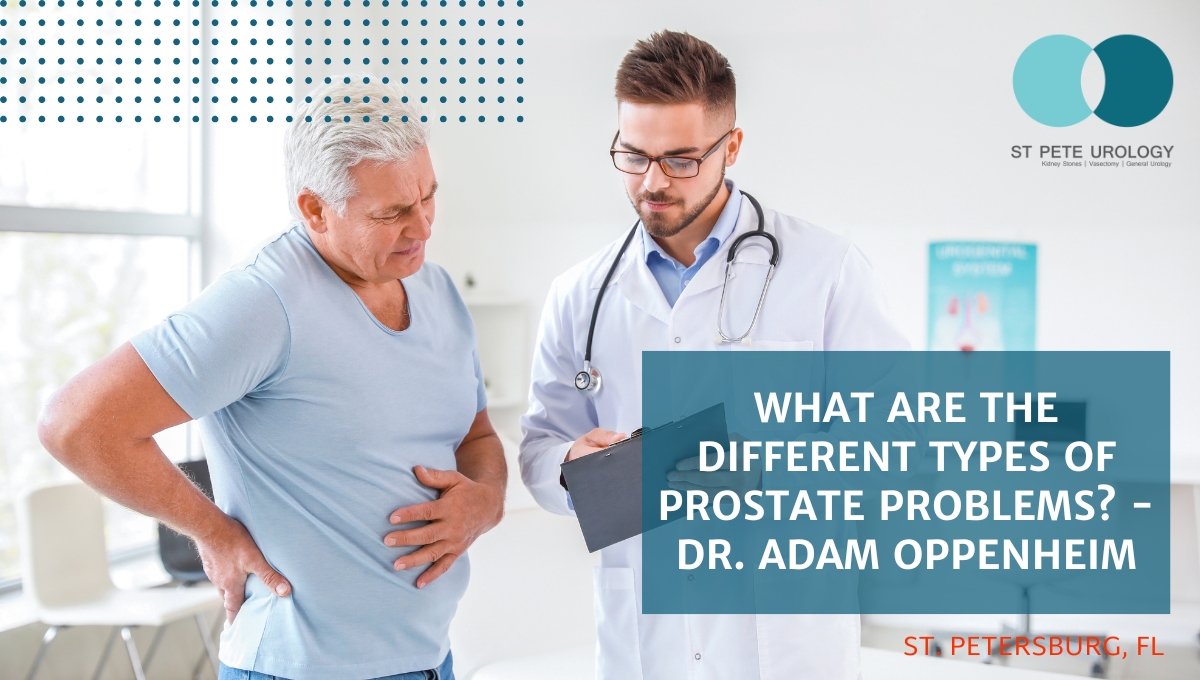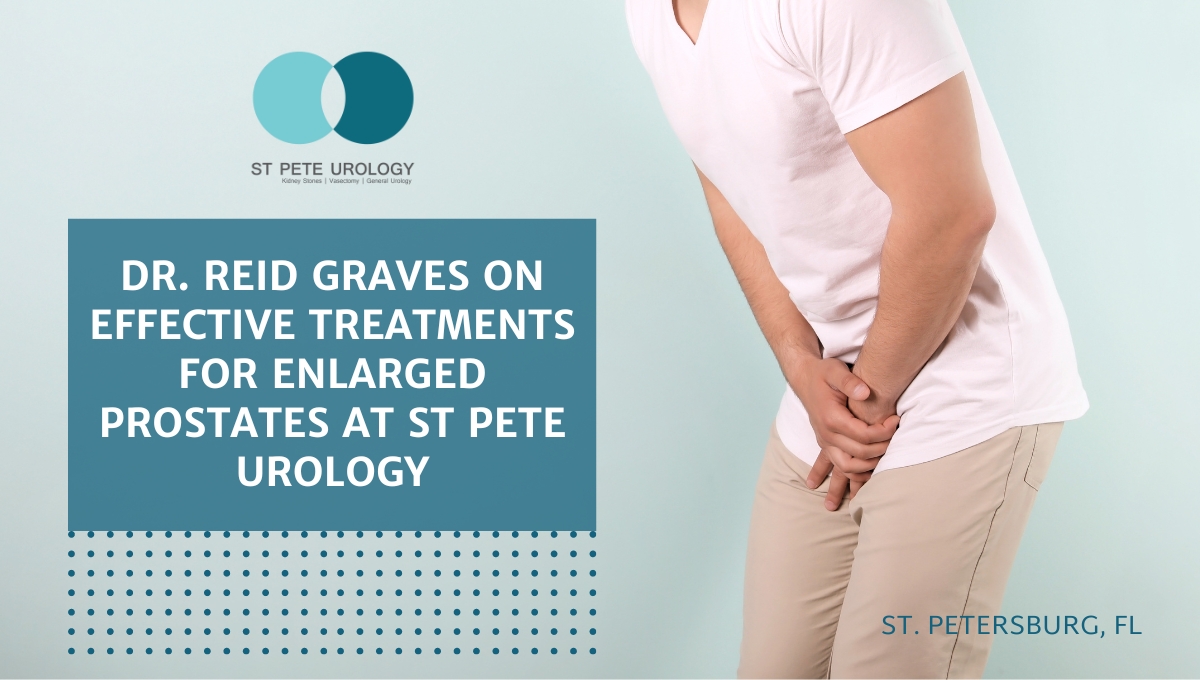Discover how HoLEP procedure and modern BPH treatments offer lasting relief from enlarged prostate symptoms with faster recovery. Expert care in St Petersburg, FL.
Continue readingWhat Are the Latest Treatments for Enlarged Prostate?
Explore the latest treatment for enlarged prostate, including minimally invasive options like Rezūm and Aquablation, to improve urinary symptoms effectively.
Continue readingWhy Do Older Men Struggle with Frequent Urination?
Discover why frequent urination in older men occurs, its impact on daily life, and effective treatment options to improve quality of life.
Continue readingHow Effective Are Non-Surgical Treatments for BPH?
How effective are non-surgical treatments for BPH? Understanding these treatments is a complex one, so find out more with St. Pete Urology.
Continue readingHow Does an Enlarged Prostate Affect Urinary Function?
How does an enlarged prostate affect urinary function? Getting UTI, bladder stones or kidney damage are just some possible symptoms.
Continue readingBPH (Enlarged Prostate): What Is It?
What is BPH or Enlarged Prostate? BPH is a condition that will affect the prostate of nearly every man at some point after the age of 40.
Continue readingUnderstanding Prostate Enlargement: Myths and Facts
How much of what you hear about prostate enlargement is true? Learn about the myths and misconceptions about prostate enlargement or BPH.
Continue readingProstate Enlargement: What Every Man Should Know
By the time you reach the golden age of fifty and beyond, it’s not uncommon to experience symptoms of an enlarged prostate. Learn more here.
Continue readingAdvancements in Men’s BPH Treatment: UroLift Technology by Dr. Reid Graves
Key Takeaways:
- The UroLift technology is a minimally invasive device that staples the lobes of the prostate apart from each other, allowing for a much quicker recovery experience without a catheter.
- The UroLift technology is the only device that does not have the side effect of retrograde ejaculation, making it a viable treatment option for men grappling with BPH.
- St. Pete Urology is a leading urology practice offering state-of-the-art BPH treatment options, including the UroLift technology. Their commitment to delivering the best care to their patients makes them a trustworthy option for pursuing BPH treatment.
Navigating the path of finding the right BPH treatment can be a labyrinthine task. Over the years, advancements have been made in the field, but with each progress comes a new set of challenges. That’s where the UroLift technology steps in. It is a minimally invasive device yoking the future of urology with the demands of the contemporary patient. Spearheading this revolution in BPH treatment is Dr. Reid Graves, a board-certified urologist based in St. Petersburg, FL.
Embracing New Technologies
Dr. Graves, of St. Pete Urology, eloquently elucidates how the UroLift technology is adding a groundbreaking dimension to urology. He says, “There have been new technologies that have recently come out with a device called the UroLift technology, which essentially is a stapling device that staples the lobes of the prostate apart from each other so that the patient can void through their prostate.”
This advanced device, in Dr. Graves’ own words, “is an exciting new advancement in the era of BPH treatment for a couple of reasons.” It’s minimally invasive technology with almost no blood loss. Moreover, patients can even return home without a catheter, dramatically enhancing their recovery experience.
Addressing Troubling Side Effects
Technological triumph is praiseworthy. However, the true gauge of new treatments is its capacity to relieve the side effects that previously afflicted patients. One such side effect, often linked with BPH treatment, is retrograde ejaculation. This occurs when the ejaculate reverses into the bladder during orgasm. It prevents patients from seeing their ejaculate during intercourse, a predicament that disturbs many men.
Fortunately, in the case of the UroLift device, as Dr. Graves informs us, “This new treatment, the UroLift device, is the only device which does not have this side effect.” This revelation solidifies UroLift’s standing as a viable treatment option for men grappling with BPH.
A Brighter Future for BPH Treatment
The advent of UroLift technology highlights the fact that even in a field as intricate as urology, there is always room for innovation. By creating a less invasive treatment option, the field of urology has proven its commitment to patient wellbeing once more.
Looking ahead, it’s clear that UroLift technology is leading the charge in transforming the face of BPH treatment. From its efficacy to the lack of troubling side effects, the device has emerged as a promising solution to an enduring problem.
Trust St. Pete Urology for Top-Notch Treatment
St. Pete Urology, a leading urology practice in St. Petersburg, Florida, continues to be at the epicenter of these advancements, offering state-of-the-art BPH treatment options. These include the groundbreaking UroLift technology, a testament to their commitment to delivering the best care to their patients.
Through the skilled guidance of Dr. Reid Graves, St. Pete Urology is creating a better tomorrow, one patient at a time. So, trust St. Pete Urology to guide you through the web of decisions. Their understanding, expertise, and dedication to patient care set them apart from the rest. This ensures that you receive the most targeted and effective BPH treatment.
References:
- “UroLift Procedure for BPH (Enlarged Prostate) – Overview and Cost.” https://www.urologysanantonio.com/bph-enlarged-prostate/urolift-procedure.
- “Benign Prostatic Hyperplasia (BPH) – Urology Care Foundation.” https://www.urologyhealth.org/urology-a-z/b/benign-prostatic-hyperplasia-(bph).
- “Retrograde ejaculation – Symptoms and causes – Mayo Clinic.” 11 Jan. 2022, https://www.mayoclinic.org/diseases-conditions/retrograde-ejaculation/symptoms-causes/syc-20354890.
Transcription:
Hi, I’m Dr. Reid Graves and I’m a board certified urologist at St. Pete Urology. There have been new technologies that have recently come out with a device called the UroLift technology, which essentially is a stapling device that staples the lobes of the prostate apart from each other so that the patient can void through their prostate. Now this is an exciting new advancement in the era of BPH treatment for a couple of reasons. One, it is extremely minimally invasive with almost no blood loss and patients can even go home without a catheter.
In addition, one of the most troubling side effects for men with treatment of BPH is retrograde ejaculation. This is when the ejaculate goes backwards into the bladder when a patient is having an orgasm and they’re unable to see their ejaculate during intercourse. This is often something that bothers men and this new treatment, the UroLift device, is the only device which does not have this side effect. And so this is something that is a new exciting advancement in this field.
Dr. Reid Graves on Effective Treatments for Enlarged Prostates at St Pete Urology
Key Takeaways:
- Treatments for enlarged prostates require careful consideration of various factors to create a personalized treatment plan.
- TURP and GreenLight laser treatments are effective methods of managing an enlarged prostate.
- St Pete Urology provides expert care and quick recovery times for prostate enlargement treatments.
As men age, they may face the common yet uncomfortable issue of prostate enlargement. In St. Petersburg, FL, there’s a urologist who understands the intricacies of this condition – Dr. Reid Graves of St Pete Urology. In his words, “One of the things we take pride in here at St. Pete Urology is the management of patients with enlarged prostates.” So, what makes his approach so effective? Let’s dive in and explore Dr. Graves’ effective treatments of enlarged prostates.
Determining the Best Treatment
Treating an enlarged prostate isn’t a one-size-fits-all approach. Instead, it requires careful consideration of various factors. These factors include the patient’s overall health, comorbid conditions, and potential complications from blood thinners, as explained by Dr. Graves. The goal, of course, is to create a personalized treatment plan that best suits each patient’s needs.
TURP and GreenLight Laser: Two Effective Treatment Options
There are many different treatment options available for managing an enlarged prostate. Two of the most effective methods, according to Dr. Graves, are TURP (transurethral resection of the prostate) and GreenLight laser prostatectomy.
TURP involves the use of a hot knife that is inserted through the urethra to cut out pieces of tissue from the prostate. This procedure can be invasive, but it often produces excellent results for patients with severe urinary symptoms or obstruction.
Alternatively, Dr. Graves also recommends the GreenLight laser prostatectomy. This procedure is unique because the laser used is absorbed by hemoglobin in the blood. This minimizes blood loss during surgery. Interestingly, Dr. Graves can perform this treatment on patients taking blood thinners. This makes it a versatile option for many men dealing with prostate enlargement.
The “Apple Core” Analogy
To help his patients understand the goals of these treatments, Dr. Graves uses the analogy of an apple. Imagine the prostate as an apple, and the core is the part where urine travels through. In order to improve a patient’s ability to urinate, the “apple core” must be removed to create more space for the urine to pass. Both TURP and GreenLight laser procedures can effectively achieve this goal by removing excess tissue from the prostate with precision and care.
Quick Recovery Times
One of the most striking aspects of Dr. Graves’ treatment methods is the speedy recovery time. With the GreenLight laser prostatectomy, patients can expect to have their catheter removed the day after the procedure, and it could even be a same-day surgery. This quick turnaround allows men to return to their regular activities with minimal disruption, making it an attractive option for those seeking relief from their prostate enlargement symptoms.
Choose St Pete Urology for Expert Care
If you or a loved one are dealing with the challenges of prostate enlargement, it’s crucial to find a skilled and compassionate urologist who will prioritize your needs and well-being. In St. Petersburg, FL, Dr. Reid Graves and the team at St Pete Urology are known for their dedication to providing the highest level of care to patients facing this common yet complex condition. Don’t leave your health in the hands of just anyone – trust the experience and expertise of St Pete Urology to guide you toward the most effective treatments for enlarged prostates.
References:
- “Transurethral Resection of the Prostate (TURP).” https://www.hopkinsmedicine.org/health/treatment-tests-and-therapies/transurethral-resection-of-the-prostate-turp.
- “What Is A GreenLight Laser Prostatectomy? | QProstate.” https://qprostate.com.au/greenlight-laser-prostatectomy/greenlight-laser-prostatectomy/.
- “Enlarged Prostate (BPH) – Symptoms and Causes – Penn Medicine.” https://www.pennmedicine.org/for-patients-and-visitors/patient-information/conditions-treated-a-to-z/enlarged-prostate.
Transcription:
My name is Reid Graves and I’m a urologist at St Pete Urology. One of the things we take pride in here at St. Pete Urology is the management of patients with enlarged prostates. This is a very common problem as men age and oftentimes people will have difficulty urinating. If their symptoms are significant enough or they’re unable to urinate, oftentimes a surgery will be indicated. Determining which surgery is right for the patient depends on a variety of factors including their comorbid conditions, their health, and if they’re on any blood thinners. Some of the options include a TURP or transurethral resection of the prostate in which a hot knife is used through the urethra in order to cut out the pieces of the tissue in the prostate.
Another option is to use the GreenLight laser to perform a GreenLight laser prostatectomy. This laser is unique because the laser is absorbed by hemoglobin which is in the blood. This provides the patient with minimal blood loss during the procedure and we’re actually able to perform these procedures in patients that are on blood thinners. Essentially when patients have enlarged prostates, the prostate is like an apple. The apple core is the part where the urine travels through the apple. In order for us to allow patients to urinate better, we use our instruments to remove the apple core from the apple so that the urine can flow through the apple. We can use the GreenLight laser to perform this with a same day procedure or at the most patients will stay overnight one day and then we will remove their catheter the following day.

